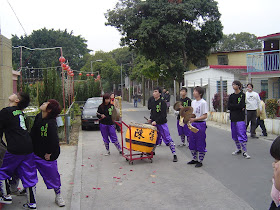You could be forgiven for thinking that after the fireworks that would be it for yet another year, and so it was in most of Hong Kong: prices remained high throughout the week, especially in restaurants and food markets, and the territory was slow to get back to business as usual, as usual. And, according to tradition, it is imperative to get out of the house on the third day to avoid quarrels, which are believed to last all year if they occur on that day, but nothing of note actually happens, apart from the quarrels about where to go, given that it’s still a public holiday and almost nowhere is open.
However, San Wai’s dinner is always held on the eighth day of the new year and is a big occasion: it is held in the open air, hence the concerns over the weather, and this year there were thirty-seven tables, each accommodating between ten and twelve diners, some of whom will have been guests of village residents. And, remember, this is a Chinese dinner, which means in this case eleven courses, all cooked in the open; it is a mammoth logistical challenge, and after days of damp, dreary weather, it must have been a relief to the organizers to see the clouds lift and the temperature rise a few degrees.
The day starts with a ritual to bless the roast pig that the village purchases every year. It is a quasi-religious ceremony with incense, the burning of paper money and ritual obeisances at an impromptu altar (a table covered with red paper). My assumption is that the beliefs behind it are connected with fung shui, although when I declined to join in everyone assumed that it was because I’m a Christian, which I’m not. It appears to be based on a mixture of Taoist and animist beliefs, with rice wine poured on the ground as an offering to the gods. Last year, the ceremony was more meticulously observed, while this year’s ceremony was much more of an ad hoc affair that I thought was rushed through.
I suspect that one reason for the hurry was that this year the village had bought two pigs, one of which was promptly chopped up and scoffed on the spot in a most convivial atmosphere. The meat is very fatty, but the skin is crunchy and absolutely delicious, especially when washed down with a couple of glasses of beer. The second pig was also chopped up, after which portions were distributed to every house in the village as per tradition.
Preparations for the dinner went on all afternoon, and this year the organizers had booked live musical entertainment: not to my tastes, although I did enjoy the Cantonese opera singer. Backed by an electric trio of bass, drums and keyboards, she sounded better than would have been the case in a more traditional setting, and to my surprise she sang mostly duets, switching from the male to the female role with remarkable ease.
If you have any Chinese friends, you will probably be aware that they light up like a clown’s nose after only moderate consumption of alcohol, and moderation is not on the agenda on occasions like these. We were well supplied with both wine and beer. In addition to a toast as each dish comes to the table, groups of topers go from table to table proposing additional toasts. And everyone has a good time.
The highlights of the dinner itself were the deep-fried prawn balls and the eight ingredients stuffed duck. The number of ingredients in the stuffing relates to the allegedly lucky properties of the number eight, although I have to confess that I could detect only two: chick peas and lotus seeds. You will assume, correctly, that everyone is full by the time courses nine and ten arrive, which is why these are always egg fried rice and braised e fu noodles, or something similar, designed merely to fill up the unfilled.
By this time, everyone was fairly merry. Uncle Chu, a familiar and popular figure in the village, his face lit up like a Christmas tree, was dancing enthusiastically to the music, but when the glamorous Cantopop singer offered to dance with him (while continuing to sing), he shot up the stairs leading from the dining area (aka the car park) like a rabbit down its hole when a fox appears in the neighbourhood, clearly embarrassed.
The Spring Festival, as it is known in mainland China, continues until Sunday, but as far as San Wai is concerned that’s it for another year. Lung ma tsing san.
The ritual carving of the first pig.
The pig is chopped into bite-sized pieces; dipping sauces can be seen in front of the chopping block.
Thirty-seven tables are set out in the car park alongside the east wall of the village.
What remains of the last five courses, including the eight ingredients stuffed duck and the 'fillers'.








